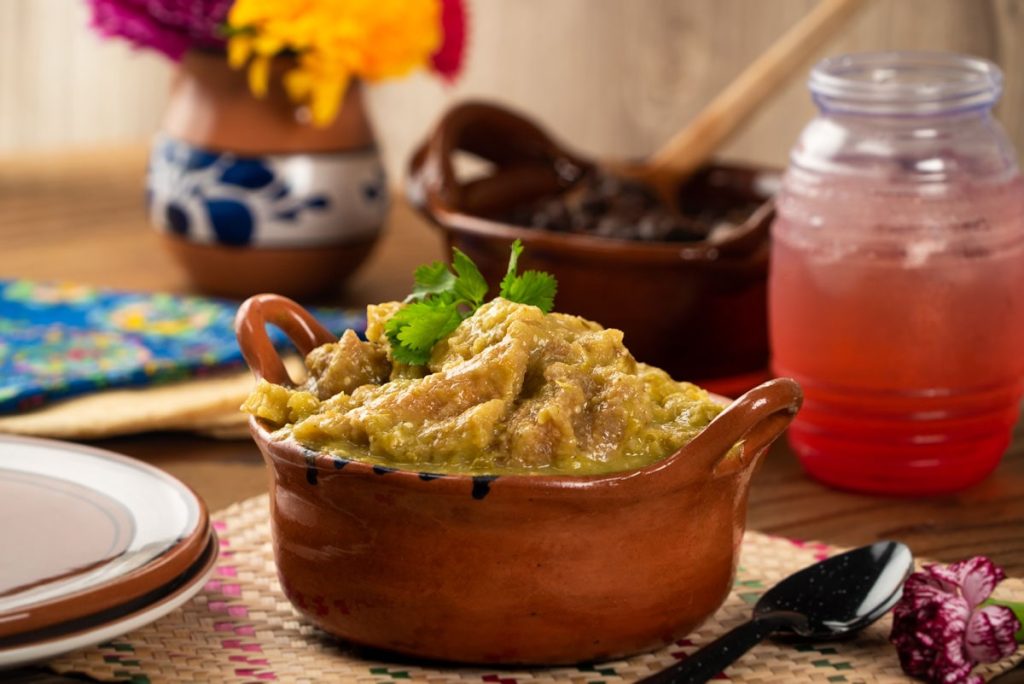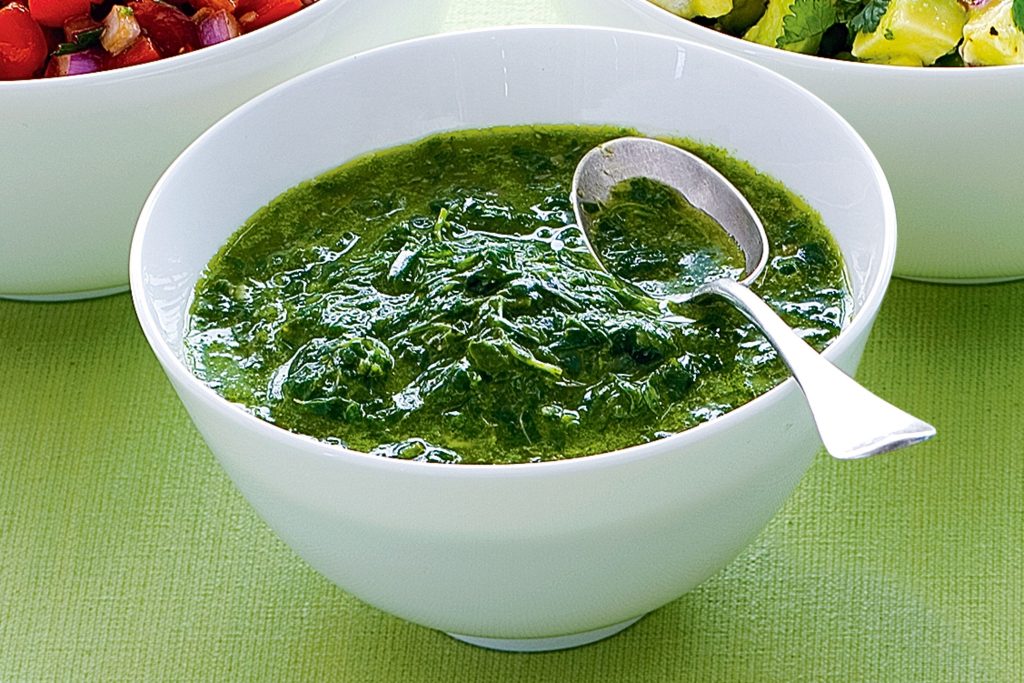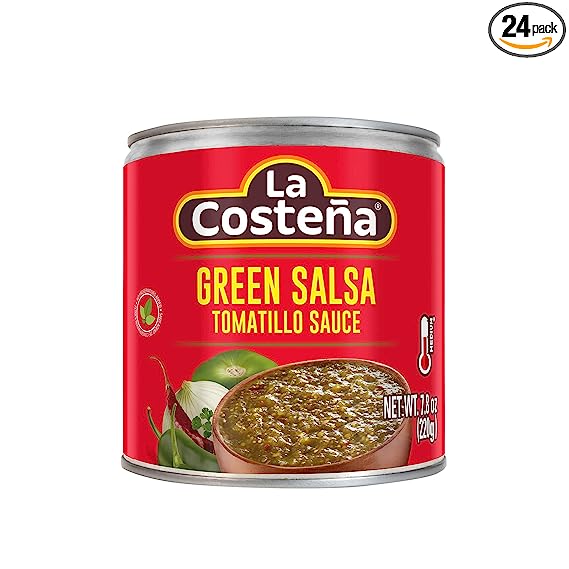Chicharon Salsa Verde: A Tasty and Tangy Delight
If you’re a fan of Mexican cuisine, you’ve likely encountered various salsas that add a burst of flavor to your favorite dishes. One such salsa that stands out is the Chicharon Salsa Verde. This delectable sauce combines the crispy texture of chicharrones with the tanginess of green salsa, creating a delightful taste experience that will leave your taste buds craving for more. In this article, we will explore the origins, ingredients, preparation, and serving suggestions of Chicharon Salsa Verde, so get ready to embark on a journey of culinary delight.

1. Introduction
Chicharon Salsa Verde is a unique and flavorful sauce that combines the traditional elements of Mexican cuisine. The salsa is known for its vibrant green color and tangy taste. It is a popular accompaniment to a variety of dishes, including tacos, quesadillas, and grilled meats. The combination of crispy chicharrones and the zesty flavors of the salsa verde makes for an unforgettable culinary experience.
2. Origins of Chicharon Salsa Verde
Chicharon Salsa Verde has its roots in Mexican cuisine, where salsas play a crucial role in enhancing the flavors of different dishes. The use of chicharrones, which are fried pork rinds, adds a unique twist to the traditional green salsa. This fusion of ingredients creates a distinct texture and taste that sets Chicharon Salsa Verde apart from other salsas.
3. Ingredients
To create Chicharon Salsa Verde, you will need the following ingredients:
- 1 cup of fresh tomatillos, husked and washed
- 1 jalapeno pepper, stemmed and seeded
- 1/2 cup of chopped white onion
- 2 cloves of garlic
- 1 cup of fresh cilantro leaves
- Juice of 1 lime
- Salt to taste
- 1 cup of chicharrones, crushed
These ingredients can be easily found in most grocery stores or local markets. Make sure to choose fresh and ripe tomatillos for the best flavor.

4. Preparation
Here’s a step-by-step guide on how to prepare Chicharon Salsa Verde:
- In a pot of boiling water, cook the tomatillos and jalapeno pepper until they become soft and change color.
- Drain the cooked tomatillos and jalapeno pepper and allow them to cool.
- In a blender or food processor, combine the cooked tomatillos, jalapeno pepper, chopped onion, garlic, cilantro leaves, lime juice, and salt.
- Blend the ingredients until you achieve a smooth and homogeneous consistency.
- Transfer the salsa to a bowl and stir in the crushed chicharrones.
- Let the flavors meld together for at least 30 minutes before serving.
5. Serving Suggestions
Chicharon Salsa Verde can be enjoyed in various ways. Here are a few serving suggestions to tantalize your taste buds:
- Use it as a dip for tortilla chips or fresh vegetables.
- Spoon it over grilled chicken or steak for an extra burst of flavor.
- Drizzle it on tacos, quesadillas, or enchiladas to add a tangy kick.
- Mix it with sour cream or Greek yogurt to create a creamy and zesty dip.
Feel free to experiment and explore different culinary combinations to find your favorite way of enjoying Chicharon Salsa Verde.
6. Conclusion
In conclusion, Chicharon Salsa Verde is a unique and flavorful sauce that combines the crispy texture of chicharrones with the tanginess of green salsa. It adds a delightful twist to traditional Mexican dishes and can elevate your culinary experience to new heights. By following the simple steps outlined in this article, you can create this tantalizing salsa in the comfort of your own kitchen. So why wait? Grab the ingredients, get cooking, and indulge in the vibrant flavors of Chicharon Salsa Verde.
7. FAQs
Q1: Can I make Chicharon Salsa Verde spicier?
A: Absolutely! If you prefer a spicier salsa, you can add additional jalapeno peppers or even experiment with hotter chili varieties like serrano or habanero.
Q2: Can I store Chicharon Salsa Verde?
A: Yes, you can store Chicharon Salsa Verde in an airtight container in the refrigerator for up to a week. Just make sure to give it a good stir before serving.
Q3: Can I substitute chicharrones with something else?
A: While chicharrones add a unique texture to the salsa, you can substitute them with crushed tortilla chips for a similar effect.
Q4: Is Chicharon Salsa Verde gluten-free?
A: Yes, Chicharon Salsa Verde is typically gluten-free. However, it’s always best to check the labels of the chicharrones and other ingredients to ensure they are gluten-free.
Q5: Can I freeze Chicharon Salsa Verde?
A: It’s not recommended to freeze Chicharon Salsa Verde as the texture may change once thawed. It’s best enjoyed fresh for optimal flavor and consistency.
In summary, Chicharon Salsa Verde is a delicious and tangy salsa that brings a unique twist to Mexican cuisine. With its bold flavors and crispy chicharrones, it’s sure to impress your taste buds and add a burst of excitement to your favorite dishes. So, give it a try and enjoy the mouthwatering goodness of Chicharon Salsa Verde today.
Chicharron Recipe: A Delicious and Crunchy Delight
Are you ready to embark on a culinary journey filled with flavor and crunch? Look no further than the chicharron recipe, a dish that will tantalize your taste buds and leave you craving for more. In this article, we will explore the art of making chicharron from scratch, providing you with step-by-step instructions to create this mouthwatering delight in the comfort of your own kitchen.

1. Introduction: What is Chicharron?
Chicharron is a popular dish in many Latin American countries, known for its crispy and flavorful characteristics. It typically consists of fried pork rinds or pork belly that have been seasoned with spices and herbs. Chicharron can be enjoyed as a snack on its own or used as a topping for various dishes, adding an irresistible crunch and savory element.
2. Ingredients
To make delicious chicharron, you will need the following ingredients:
- 2 pounds of pork belly or pork rinds
- 2 tablespoons of salt
- 1 tablespoon of black pepper
- 1 tablespoon of paprika
- 1 tablespoon of garlic powder
- Vegetable oil for frying
3. Preparing the Pork
If you are using pork belly, start by cutting it into small pieces, about 2 inches in size. Ensure that the skin is still intact, as it will become delightfully crispy during the frying process. If you are using pork rinds, skip this step as they are already prepared.
4. Marinating the Pork
In a bowl, combine the salt, black pepper, paprika, and garlic powder. Mix well to create a flavorful seasoning blend. Take the pork pieces or pork rinds and rub them thoroughly with the seasoning, ensuring every inch is coated evenly. Allow the meat to marinate for at least 30 minutes, or refrigerate overnight for maximum flavor infusion.
5. Preparing the Frying Oil
In a large, deep frying pan or Dutch oven, pour enough vegetable oil to submerge the pork pieces or pork rinds completely. Heat the oil over medium-high heat until it reaches a temperature of 375°F (190°C). Maintaining the right oil temperature is crucial to achieve a crispy texture.
6. Frying the Chicharron
Carefully place the pork pieces or pork rinds into the hot oil, making sure not to overcrowd the pan. Fry them in batches, if necessary, to ensure even cooking. Allow the chicharron to cook for about 8 to 10 minutes, or until they turn golden brown and become crispy. Use a slotted spoon or tongs to remove them from the oil and drain on a paper towel-lined plate.
7. Seasoning the Chicharron
While the chicharron are still hot, sprinkle them with additional salt or your preferred seasoning to enhance the flavor. You can get creative and experiment with different spices, such as chili powder, cayenne pepper, or even a squeeze of fresh lime juice.
8. Serving and Enjoying
Chicharron is best enjoyed immediately after frying while it is still warm and crispy. Serve it as an appetizer with a tangy dipping sauce or as a side dish alongside beans, rice, and fresh salsa. The combination of textures and flavors will leave you wanting more with each bite.

9. Variations of Chicharron
Chicharron recipes may vary across different cultures and regions. In some places, chicharron is made with chicken skin or even fish skin instead of pork. These variations offer unique flavors and textures, allowing you to explore different culinary experiences.
10. Tips and Tricks for Perfect Chicharron
- Ensure the pork skin is dry before frying to achieve maximum crispiness.
- Use a deep-frying thermometer to monitor the oil temperature accurately.
- Cut the pork belly into smaller pieces for bite-sized chicharron.
- Experiment with different seasonings to create your signature chicharron flavor.
Conclusion
In conclusion, chicharron is a delectable dish that combines the pleasures of crunchiness and savory flavors. By following the steps outlined in this article, you can create your own batch of homemade chicharron that will impress family and friends. Whether enjoyed as a snack or part of a larger meal, chicharron will undoubtedly satisfy your cravings for a delightful and indulgent treat.
Frequently Asked Questions (FAQs)
1. What is the best cut of pork to use for chicharron?
The best cut of pork for chicharron is pork belly, as it has the perfect balance of meat and fat, resulting in tender and flavorful chicharron.
2. Can I make chicharron using an air fryer?
While traditional chicharron is deep-fried, you can achieve a similar texture using an air fryer. However, the results may not be as crispy as the traditional method.
3. How long does it take to fry chicharron?
The frying time for chicharron is typically around 8 to 10 minutes, depending on the size and thickness of the pork pieces. Ensure they turn golden brown and become crispy before removing them from the oil.
4. Can I store leftover chicharron?
Yes, you can store leftover chicharron in an airtight container at room temperature for up to 2 days. Reheat them in the oven or toaster oven to regain some of their crispiness before serving.
5. Are there any alternative seasonings for chicharron?
Absolutely! You can customize the seasoning for your chicharron based on your preferences. Try adding spices like cumin, smoked paprika, or even a hint of cinnamon to create unique flavor profiles.
Incorporate this delicious chicharron recipe into your culinary repertoire and enjoy the irresistible combination of crispy, flavorful pork. Impress your loved ones with this traditional Latin American delicacy, and don’t hesitate to experiment with different variations and seasonings to create your own chicharron masterpiece.
Salsa Verde Recipe: A Tangy and Flavorful Delight
Are you a fan of Mexican cuisine? Do you love the vibrant flavors and zesty tastes that come with it? If so, then salsa verde is a must-try condiment for you. In this article, we will guide you through the process of creating a delicious salsa verde recipe that will leave your taste buds craving for more. From the tangy tomatillos to the aromatic herbs and spices, this salsa verde will elevate your meals to a whole new level of deliciousness. So, let’s dive into the world of flavors and discover how to make this mouthwatering salsa verde.
Introduction
Salsa verde, also known as green salsa, is a tangy and vibrant condiment widely used in Mexican cuisine. It adds a burst of flavor to various dishes, from tacos and enchiladas to grilled meats and seafood. Made with fresh ingredients like tomatillos, onions, cilantro, and jalapeños, salsa verde offers a refreshing and zesty taste that complements a wide range of dishes. In this article, we will walk you through a simple and delicious salsa verde recipe that you can easily recreate at home.
What is Salsa Verde?
Salsa verde is a versatile Mexican sauce characterized by its bright green color and tangy flavor. Unlike traditional red salsa, which is made with tomatoes, salsa verde gets its vibrant hue from tomatillos, a small green fruit resembling a green tomato. The tomatillos are the star ingredient in this recipe and provide a unique tartness to the salsa. Combined with other flavorful ingredients, salsa verde offers a delightful balance of acidity, heat, and herbaceousness.
Ingredients Required
To make a classic salsa verde, you will need the following ingredients:
- 1 pound (450 grams) tomatillos, husked and rinsed
- 1 small onion, roughly chopped
- 2 cloves of garlic
- 1 jalapeño pepper, seeds and membranes removed (adjust according to spice preference)
- 1/2 cup fresh cilantro leaves
- 1 tablespoon lime juice
- 1/2 teaspoon salt, or to taste
Step-by-Step Preparation
Now, let’s get into the nitty-gritty of preparing this tantalizing salsa verde.
Step 1: Roasting the Tomatillos
- Preheat your broiler or grill to medium-high heat.
- Place the tomatillos on a baking sheet or directly on the grill grates.
- Roast the tomatillos for about 5-7 minutes, turning them occasionally until they are lightly charred and softened.
Step 2: Preparing the Other Ingredients
- In a blender or food processor, combine the roasted tomatillos, chopped onion, garlic cloves, jalapeño pepper, cilantro leaves, lime juice, and salt.
- Pulse the mixture until you achieve your desired consistency. For a chunkier salsa, pulse it a few times. If you prefer a smoother texture, blend it for a longer duration.
Step 3: Blending the Ingredients
- Once the ingredients are blended, taste the salsa and adjust the seasoning if necessary. You can add more salt, lime juice, or jalapeño pepper according to your preference.
- If the salsa verde is too thick, you can add a tablespoon or two of water and blend it again until you achieve the desired consistency.
Step 4: Adjusting the Consistency and Seasoning
- Transfer the salsa verde to a bowl or airtight container. Allow it to sit at room temperature for 15-20 minutes to let the flavors meld together.
- After the resting period, give the salsa verde a final taste and adjust the seasoning if required.
Serving Suggestions
Now that your salsa verde is ready, here are a few ways to enjoy it:
- Dip: Serve the salsa verde with tortilla chips or vegetable crudités for a zesty and refreshing appetizer.
- Tacos: Add a spoonful of salsa verde to your favorite tacos, whether they’re filled with grilled meat, fish, or vegetarian ingredients.
- Enchiladas: Drizzle salsa verde over enchiladas for a burst of tanginess that complements the richness of the dish.
- Grilled Meats: Use salsa verde as a marinade or topping for grilled chicken, steak, or seafood to enhance the flavors.
- Eggs: Spoon salsa verde over scrambled or fried eggs for a zingy breakfast treat.
Health Benefits of Salsa Verde

Salsa verde not only adds a delightful taste to your meals but also offers several health benefits. Here are a few:
- Nutrient-rich: Tomatillos, the main ingredient of salsa verde, are a good source of vitamins A and C. They also contain minerals like potassium and iron.
- Antioxidants: Tomatillos are rich in antioxidants, which help protect your cells from damage caused by free radicals.
- Low in Calories: Salsa verde is a low-calorie condiment, making it a healthier choice compared to creamy dressings or heavy sauces.
- Immune Boosting: The vitamin C content in salsa verde can support your immune system and promote overall well-being.
Frequently Asked Questions (FAQs)
- Can I use canned tomatillos for salsa verde? While fresh tomatillos are preferred for their bright flavor, you can use canned tomatillos if fresh ones are not available. Just make sure to drain and rinse them before using.
- How long can I store salsa verde? Homemade salsa verde can be stored in the refrigerator for up to one week in an airtight container.
- Can I adjust the spice level of salsa verde? Absolutely! You can control the spiciness by adjusting the amount of jalapeño pepper used. For a milder version, remove the seeds and membranes from the jalapeño or use a smaller amount.
- What can I do if salsa verde is too spicy for my liking? To reduce the heat, you can add a small amount of sugar, honey, or even a splash of citrus juice, like lime or lemon, to balance the flavors.
- Can I freeze salsa verde? Yes, salsa verde can be frozen for up to three months. Place it in an airtight container or freezer-safe bag, leaving some room for expansion.
Conclusion
Salsa verde is a vibrant and tangy condiment that can elevate the flavors of various dishes. By following the simple steps outlined in this article, you can create a homemade salsa verde that will impress your taste buds and add a touch of authenticity to your Mexican-inspired meals. Experiment with different serving ideas and spice levels to find your perfect balance of flavors. So, why wait? Get ready to tantalize your taste buds with this delightful salsa verde recipe.
Here Some Product :
LA Costeña Salsa Verde | Green Mexican Salsa with Tomatillos, Jalapeños and Chile de Arbol Peppers | Medium Heat | 7.76 Ounce Can (Pack of 24)

